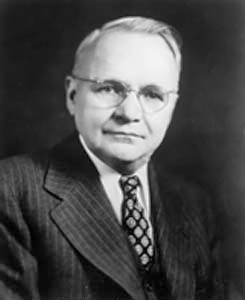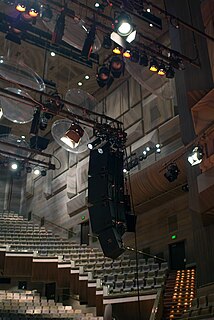Related Research Articles

Acoustics is a branch of physics that deals with the study of mechanical waves in gases, liquids, and solids including topics such as vibration, sound, ultrasound and infrasound. A scientist who works in the field of acoustics is an acoustician while someone working in the field of acoustics technology may be called an acoustical engineer. The application of acoustics is present in almost all aspects of modern society with the most obvious being the audio and noise control industries.

Aeronautics is the science or art involved with the study, design, and manufacturing of air flight–capable machines, and the techniques of operating aircraft and rockets within the atmosphere. The British Royal Aeronautical Society identifies the aspects of "aeronautical Art, Science and Engineering" and "The profession of Aeronautics ."

Harry Nyquist was a Swedish electronic engineer who made important contributions to communication theory.

Jay Wright Forrester was a pioneering American computer engineer and systems scientist. He is credited with being one of the inventors of magnetic core memory, the predominant form of random-access computer memory during the most explosive years of digital computer development. It was part of a family of related technologies which bridged the gap between vacuum tubes and semiconductors by exploiting the magnetic properties of materials to perform switching and amplification.

Acoustical engineering is the branch of engineering dealing with sound and vibration. It includes the application of acoustics, the science of sound and vibration, in technology. Acoustical engineers are typically concerned with the design, analysis and control of sound.
Quantum 1/f noise is an intrinsic and fundamental part of quantum mechanics. Fighter pilots, photographers, and scientists all appreciate the higher quality of images and signals resulting from the consideration of quantum 1/f noise. Engineers have battled unwanted 1/f noise since 1925, giving it poetic names due to its mysterious nature. The Quantum 1/f noise theory was developed about 50 years later, describing the nature of 1/f noise, allowing it the be explained and calculated via straightforward engineering formulas. It allows for the low-noise optimization of materials, devices and systems of most high-technology applications of modern industry and science. The theory includes the conventional and coherent quantum 1/f effects (Q1/fE). Both effects are combined in a general engineering formula, and present in Q1/f noise, which is itself most of fundamental 1/f noise. The latter is defined as the result of the simultaneous presence of nonlinearity and a certain type of homogeneity in a system, and can be quantum or classical.

Leo Leroy Beranek was an American acoustics expert, former MIT professor, and a founder and former president of Bolt, Beranek and Newman. He authored Acoustics, considered a classic textbook in this field, and its updated and extended version published in 2012 under the title Acoustics: Sound Fields and Transducers. He was also an expert in the design and evaluation of concert halls and opera houses, and authored the classic textbook Music, Acoustics, and Architecture, revised and extended in 2004 under the title Concert Halls and Opera Houses: Music, Acoustics, and Architecture.
Whitlow W. L. Au was a leading expert in bioacoustics specializing in biosonar of odontocetes. He is author of the widely known book The Sonar of Dolphins (1993) and, with Mardi Hastings, Principles of Marine Bioacoustics (2008). Au was honored as a Fellow of the Acoustical Society of America in 1990 and awarded the ASA's first Silver Medal in Animal Bioacoustics in 1998. He was graduate advisor to MacArthur Fellow Kelly Benoit-Bird, who credits Au for discovering how sophisticated dolphin sonar is, developing dolphin-inspired machine sonars to separate different species of fish with the goal of protecting sensitive species, and for making numerous contributions to the description of Humpback whale song, which helped protect these whales from ship noise and ship traffic.
John "Shôn" Eirwyn Ffowcs Williams, is Emeritus Rank Professor of Engineering at the University of Cambridge and a former Master of Emmanuel College, Cambridge (1996–2002). He may be best known for his contributions to Aeroacoustics, in particular for his work on Concorde. Together with one of his students, David Hawkings, he introduced the far-field integration method in computational aeroacoustics based on Lighthill's acoustic analogy, known as the Ffowcs Williams-Hawkings analogy.

The Wright Brothers Medal was conceived of in 1924 by the Dayton Section of the Society of Automotive Engineers, and the SAE established it in 1927 to recognize individuals who have made notable contributions in the engineering, design, development, or operation of air and space vehicles. The award is based on contributed research papers.
The Institute of Acoustics (IOA) is a British professional engineering institution founded in 1974. It is licensed by the Engineering Council UK to assess candidates for inclusion on ECUK's Register of professional Engineers. The institute's address is Silbury Court, 406 Silbury Boulevard, Milton Keynes MK9 2AF, United Kingdom. The current president of the IOA is Barry Gibbs. Past presidents include John Hinton OBE, Colin English, David Weston, Tony Jones, Professor Trevor Cox, William Egan, Professor Bridget Shield, and Jo Webb.
The ASA Silver Medal is an award presented by the Acoustical Society of America to individuals, without age limitation, for contributions to the advancement of science, engineering, or human welfare through the application of acoustic principles or through research accomplishments in acoustics. The medal is awarded in a number of categories depending on the technical committee responsible for making the nomination.
Acoustic quieting is the process of making machinery quieter by damping vibrations to prevent them from reaching the observer. Machinery vibrates, causing sound waves in air, hydroacoustic waves in water, and mechanical stresses in solid matter. Quieting is achieved by absorbing the vibrational energy or minimizing the source of the vibration. It may also be redirected away from the observer.
Cyril Manton Harris was Professor Emeritus of Architecture and Charles Batchelor Professor Emeritus of Electrical Engineering at Columbia University. He received his B.S. in mathematics and his M.S. in physics from UCLA, and his Ph.D. in physics from Massachusetts Institute of Technology (MIT), where he specialized in acoustics.
Gordon G. Grose was an engineer at the McDonnell-Douglas Corporation. He won the Wright Brothers Medal in 1974 with Michael J. Wendl, J. L. Porter, and Ralph Pruitt for a paper discussing future aircraft designs that integrate fly-by-wire controls with engine inlets/nozzles and advanced pilot displays.
V. Ralph Pruitt was an engineer at McDonnell Douglas who won the Wright Brothers Medal in 1974 with Michael J. Wendl, Gordon G. Grose, and J. L. Porter for a paper discussing future aircraft designs that integrate fly-by-wire controls with engine inlets/nozzles and advanced pilot displays.

NTi Audio AG is a manufacturer of test and measurement instruments for acoustics, audio and vibration applications. With headquarters in Schaan, Liechtenstein, the company specializes in end-of-line audio testing for manufacturing quality control purposes, provides instruments for testing public address systems in safety-critical environments and also produces handheld Audio Analyzers and generators aimed at the professional audio industry.
Robert Hauschild Liebeck is an American aerodynamicist, professor and aerospace engineer at the Boeing Company. He currently heads Boeing's Blended Wing Body ("BWB") program and has been a member of the National Academy of Engineering since 1992. He is best known for his contributions to aircraft design and his pioneering airfoil designs known as the "Liebeck Airfoil".
Manohar Lal Munjal is an Indian acoustical engineer, honorary professor, and INSA senior scientist at the Facility for Research in Technical Acoustics (FRITA) of the Indian Institute of Science. He is known for his studies on aeroacoustics and finite wave analysis of exhaust systems. He is an elected fellow of all the three major Indian science academies viz. Indian Academy of Sciences, Indian National Science Academy, National Academy of Sciences, India as well as the Indian National Academy of Engineering. He has published three books viz. Noise and Vibration Control, Acoustics of Ducts and Mufflers With Application to Exhaust and Ventilation System Design, and IUTAM Symposium on Designing for Quietness and has contributed chapters to books edited by himself and others. The Council of Scientific and Industrial Research, the apex agency of the Government of India for scientific research, awarded him the Shanti Swarup Bhatnagar Prize for Science and Technology, one of the highest Indian science awards for his contributions to Engineering Sciences in 1986.
Ma Dayou or Dah-You Maa was a Chinese acoustical physicist, specializing in various aspects of acoustics, especially sound generation, transmission and absorption. Academician of Chinese Academy of Sciences (CAS), Ma was a research professor at Institute of Acoustics of CAS; Chairman of Chinese National Acoustics Standardization Technical Committee; and Editor-in-Chief of Chinese Journal of Acoustics.
References
- ↑ Gregory, J. (1980) Who's Who in Engineering, 4th ed., American Association of Engineering Societies.
- ↑ Hayden, R.E. (1973) Fundamental Aspects of Noise Reduction From Powered Lift Devices, Society of Automotive Engineers paper number 730376.
| This article about an American mechanical engineer is a stub. You can help Wikipedia by expanding it. |